How Queen Margrethe of Denmark chose an exquisite gown steeped in history for a 20-minute wedding ceremony with her French sweetheart – after he changed his name to sound more Danish
On June 10, 1967, Princess Margrethe of Denmark married her French sweetheart in a quick 20-minute ceremony at Holmen Church in Copenhagen.
The future queen met diplomat Henri de Laborde de Monpeza while studying political science at the London School of Economics in the early 1960s.
The couple began courting and announced their engagement in October 1966.
Henri, who had to change his name to Henrik to sound more Danish, proposed with a striking Van Cleef & Arpels ‘moi et toi’ ring featuring two diamonds that reportedly measure six carats each.
This style was especially popular in the nineteenth century after Napoleon gave Josephine, an ancestor of Margrethe, a similar ring set with a diamond and a sapphire.
Margarethe and Henrik’s quick wedding ceremony may have been a sign of trouble to come.
The couple’s union was at times tumultuous, with Henrik at one point leaving his country for several weeks after an argument with his wife.
He also emphasized that he did not want to be buried next to Margarethe, with his secretary saying the decision was the “natural consequence of him not being treated equally with his wife.”
His wishes were honored when he passed away and his ashes were scattered in Danish waters and in the gardens of Fredonsborg Palace.
Margrethe married the French diplomat Henri de Laborde de Monpeza in 1967 in the Holmen Church in Copenhagen
To marry the future monarch of Denmark, Henri had to make several sacrifices.
In addition to changing his name, he converted from Catholicism to Lutheranism and gave up his dream to pursue his diplomatic career.
Arriving at Holmen Church on the arm of her father, King Frederick IX, Margrethe was the picture of elegance in an ivory silk dress designed by her mother’s favorite couturier, Jørgen Bender.
The Evangelical Lutheran service was performed by Erik Jensen, Bishop of Aalborg and Chaplin of the Royal Court.
Paying tribute to family traditions, Margrethe’s dress featured a square neckline and contrasting bodice, made from heirloom lace from her late grandmother, Princess Margaret of Connaught.
The design also featured a dramatic 20-foot train that provided a beautiful backdrop for the bride’s beautiful veil.
The Irish lace veil served as her ‘something borrowed’ and was previously worn by her late grandmother, Princess Margaret of Connaught, during her wedding to Prince Gustaf Adolf of Sweden at Windsor Castle in 1905.
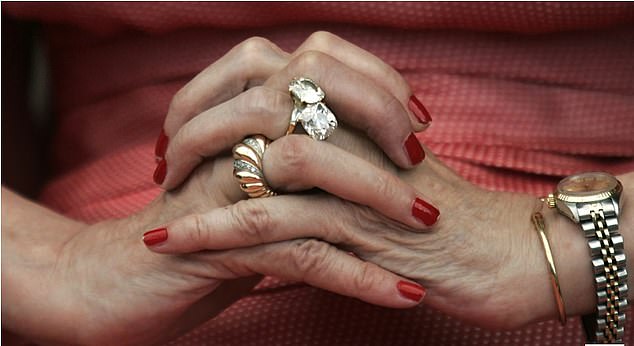
Henri proposed with a Van Cleef & Arpels ‘moi et toi’ ring, with two diamonds, each reportedly measuring six carats
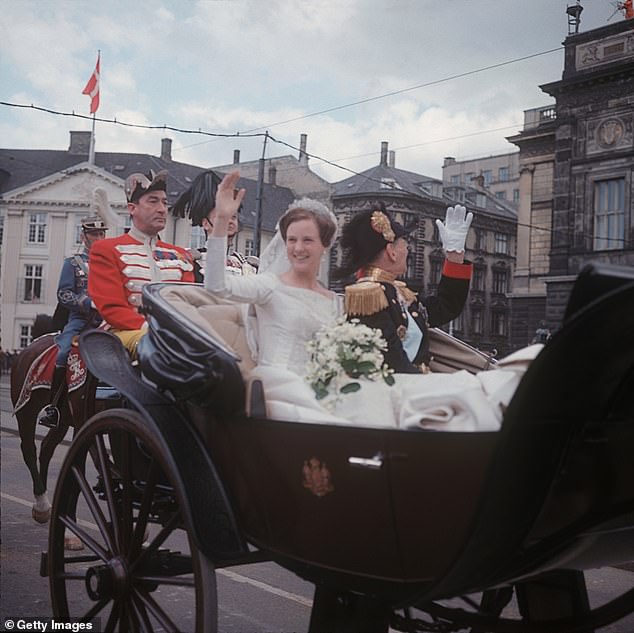
Arriving at Holmen Church on the arm of her father, King Frederick IX, Margrethe was the epitome of elegance
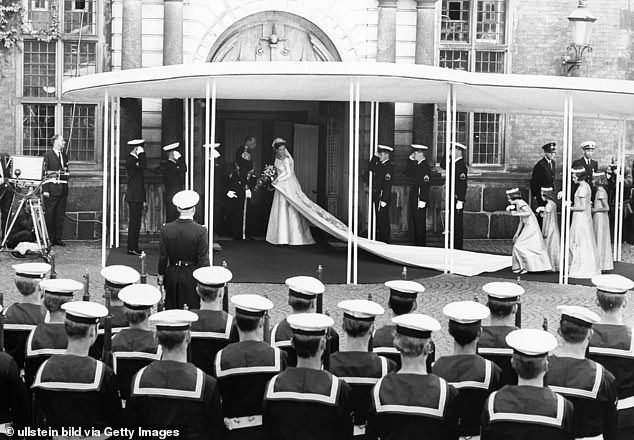
The princess wore an ivory silk dress by Danish couturier Jørgen Bender with a six-meter train
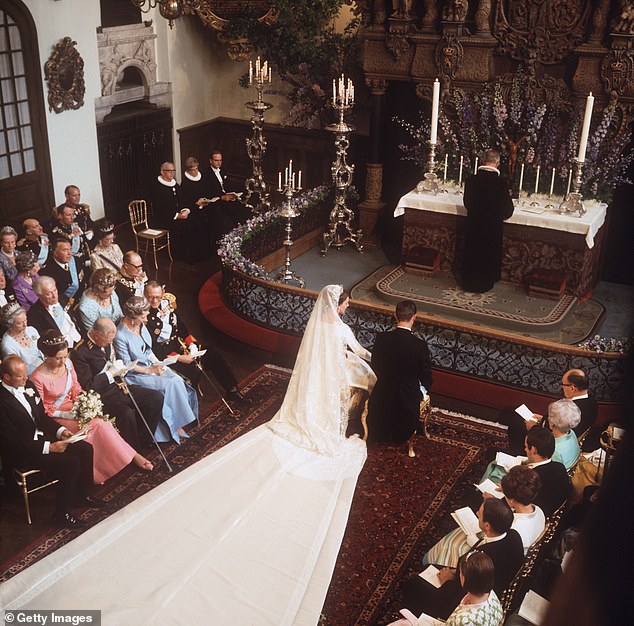
Margrethe’s Irish lace veil was previously worn by her late grandmother, Princess Margaret of Connaught, during her wedding to Prince Gustaf Adolf of Sweden at Windsor Castle in 1905
The bride showed off another striking accessory with ties to her late grandmother: the Khedive of Egypt Tiara.
This glittering head ornament was given to Margaret by the Khedive as a wedding gift in 1905.
It was worn as a bridal diadem in 1964 by Margrethe’s youngest sister, Queen Anne-Marie, and later by all of Queen Ingrid’s daughters and granddaughters.
Margrethe, a third cousin of the late Queen Elizabeth II, also wore the Diamond Daisy Brooch – a large jewel set with diamonds.
It was lent by the late Queen Ingrid of Sweden, who received the brooch from her father, King Gustaf VI Adolf of Sweden, and wore it on her wedding day in 1935.
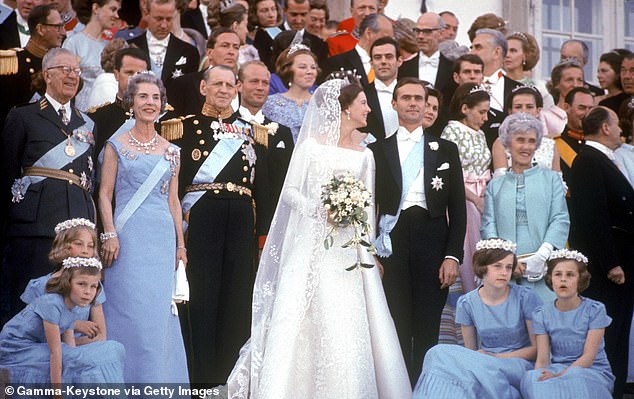
Denmark’s royal family and royal figures from other countries gathered at Fredensborg Castle to celebrate the wedding

After the ceremony, the couple went to Fredensborg Palace and waved to well-wishers from the balcony
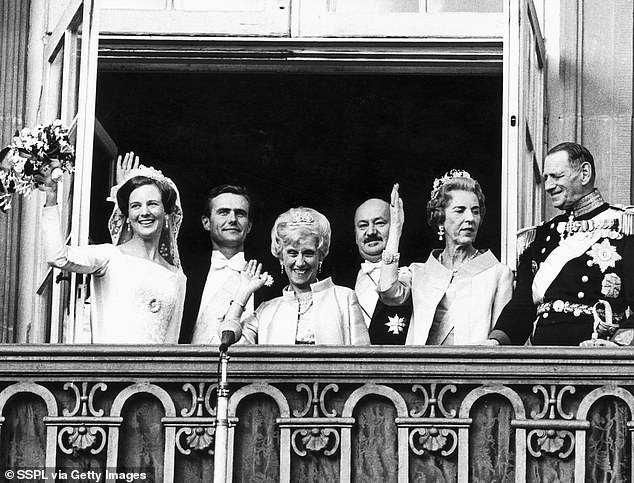
The newlyweds were joined by their delighted parents on the balcony
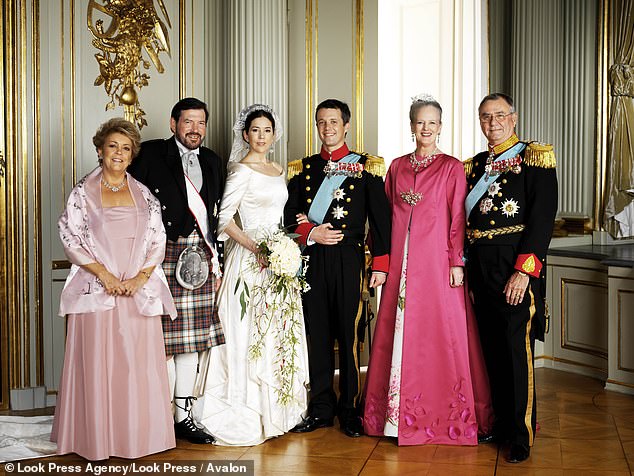
The Dutch royal family in the photo on the wedding day of Prince Frederik and Mary Donaldson in 2004

The couple’s union was at times tumultuous, with Henrik at one point leaving his country for several weeks after an argument with his wife. Above: The couple in 2002
Decades later, in 2000, Ingrid permanently donated the jewel to Margrethe, who wore it to a number of important appearances, including her New Year’s Eve speech announcing her abdication.
Margrethe completed her bridal look with a pair of diamond and pearl earrings, a gift from her husband-to-be.
After the ceremony, Crown Princess Margrethe and Prince Henrik rode in an open carriage through the streets of Copenhagen, waving to the people standing along the road.
The couple soon arrived at Fredensborg Palace, where King Frederik and Queen Ingrid hosted an extravagant reception in their honor.
During his wedding speech, Prince Henrik is said to have called his bride ‘the most beautiful flower in the lush garden of Denmark’.
The couple had two sons, Frederik, born in 1968, and Joachim, born in 1969.
Margrethe succeeded her father, King Frederick IX, upon his death in January 1972, becoming the first female Danish sovereign under the new law of succession.
In January, after 52 years on the throne, she decided to abdicate in favor of Fredrik.
